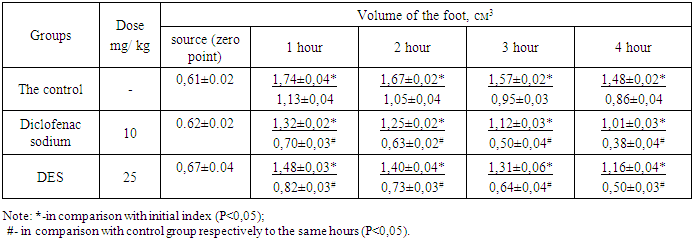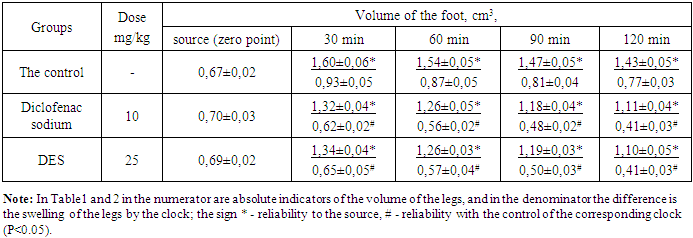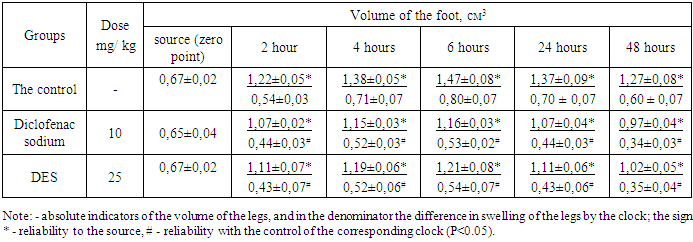-
Paper Information
- Next Paper
- Paper Submission
-
Journal Information
- About This Journal
- Editorial Board
- Current Issue
- Archive
- Author Guidelines
- Contact Us
American Journal of Medicine and Medical Sciences
p-ISSN: 2165-901X e-ISSN: 2165-9036
2020; 10(7): 503-508
doi:10.5923/j.ajmms.20201007.13

The Effect of Dry Extract Obtained from Rhus Cariaria in Experimental Models of Edema and Inflammation
Abzalov Sh. R.1, Khakimov Z. Z.2, Rakhmanov A. Kh.2
1Agency on Development of the Pharmaceutical Industry under the Ministry of Health of the Republic of Uzbekistan
2Tashkent Medical Academy, Tashkent, Uzbekistan
Correspondence to: Abzalov Sh. R., Agency on Development of the Pharmaceutical Industry under the Ministry of Health of the Republic of Uzbekistan.
| Email: |  |
Copyright © 2020 The Author(s). Published by Scientific & Academic Publishing.
This work is licensed under the Creative Commons Attribution International License (CC BY).
http://creativecommons.org/licenses/by/4.0/

The effect of dry extract obtained from Sumakha [Rhus cariaria L.] leaves (DES) on various phases of inflammation was studied using white sexually mature male rats in this study. It was found that the DES has a distinct antiexudative and antiproliferative activity comparing to the standard non-steroidal anti-inflammatory drug – diclofenac sodium (voltaren). Studies in rats have shown that the dry extract of Rhus cariaria has a distinct antiexudative effect in aseptic arthritis induced by dextran, histamine and formalin. The mechanism of the antiexudative effect was found to be because of both astringent and its antioxidant properties. The effect of the DES was obtained after enteral administration with the the dose of 25 mg/kg. The results of this experimental study indicate the possibility of using this dry extract for anti-inflammatory effect. The combination of antiviral and anti-inflammatory activity of Rhus cariaria will make it possible to increase the effectiveness of the treatment against to virus-induced pathologies in some conditions.
Keywords: Dry extract, Anti-inflammatory activity, Inflammation, Medicinal plants
Cite this paper: Abzalov Sh. R., Khakimov Z. Z., Rakhmanov A. Kh., The Effect of Dry Extract Obtained from Rhus Cariaria in Experimental Models of Edema and Inflammation, American Journal of Medicine and Medical Sciences, Vol. 10 No. 7, 2020, pp. 503-508. doi: 10.5923/j.ajmms.20201007.13.
Article Outline
1. Introduction
- Nowadays in the pathogenesis in which inflammation plays a leading role, a large number of drugs have been using (selective and non-selective non-steroidal anti-inflammatory drugs, glucocorticoid, basic anti-inflammatory drugs, biological drugs) [3,16,19]. The use of optimal regimens of these drugs does not provide a sufficient therapeutic effect [14]. Long-term use is generally associated with the risk of developing severe adverse reactions, which requires the search for new, more effective anti-inflammatory drugs, despite the abudance of traditional non-steroidal anti-inflammatory drugs on the market [5,14,28]. The medical practice in pharmacotherapy of many common pathologies is dominated by the use of drugs from natural origins. Herbal preparations are often used without any prescriptions, and patients are at the risk of exceeding the established therapeutic doses up to undesired level and facing some side effects [12]. Therefore, conducting experimental studies on the specific activity of herbal preparations is one of the important tasks of pharmacology. In this aspect, our attention was focused on dry extract isolated from the plant Rhus cariaria, which had a distinct anti-inflammatory activity on aseptic arthritis induced by various flagogens [6,7]. Considering that inflammation because of various etiologies occurs during the simultaneous course of exudation, alteration, and proliferation, it was of interest to study on the antiproliferative activity of the dry extract isolated from Sumakha leaves (DES) [Rhus cariaria L.]. Literature data show that the Tannin obtained from Sumach leaves have not effective only in inflammatory processes of the oral cavity, but they also used to treat skin diseases, which are probably associated with its anti-inflammatory formations [1]. These data have not been specifically investigated yet.The aim of this study was to study the anti-inflammatory activity of the dry extract isolated from Sumakha leaves (DES) [Rhus cariaria L.] and to compare results with the standard non-steroidal anti-inflammatory drug diclofenac sodium.In order to study the content of polyphenols in individual parts of the plant, the Institute of Bioorganic Chemistry, Academy of Sciences of the Republic of Uzbekistan named after Academician A. Sadykov used dried leaves collected during its flowering. The raw material was first extracted with chloroform to remove lipophilic compounds, then the raw material was dried and extracted three times with 70% acetone. The resulting extracts were condensed using a rotary evaporator and the aqueous concentrate was treated with ethyl acetate. The ethyl acetate fraction was concentrated in a rotor evaporator and precipitated with hexane. According to the results of studies on individual organs of plants, it is observed that the leaves of Sumakha make up 1.88-6.67%. As a result of qualitative reactions, it was observed that the sum of polyphenols contains about 70 compounds belonging to the class of flavonols, phenolic acids and tannins.
2. Material and Methods
- In the experiments, the preparation of the dry extract isolated from Sumach leaves (DES) (Rh. Coriaria) [23] was used. To assess the anti-inflammatory activity of this dry extract, its effect was determined on three models (two exudative arthritis models and "cotton pellet" model). The experiments were performed on outbred rats weighing 140 - 185 g. Before the experiment, all laboratory animals were examined considering their body weight, age, gender, and motor activities. After an external examinations, the experiment was started. The entire period of preparations, experiment, during the implementations, laboratory animals were kept in the vivarium at a temperature of 20-25°C, humidity of at least 50%, in a well-ventilated room and in day/night light mode, in standard plastic cages, 6 animals in each cages, with a standard diet, the daily requirement was in accordance with the age of the animals. All laboratory animals participating in the experiment before the start of the experiment had a healthy appearance and were observed active.
2.1. The Antiexudative Effect of DES
- The antiexudative effect was studied on a model of acute inflammatory edema of the paw of the rat, induced by introducing injection of 0.1 ml of solutions of 6% dextran, 0.1% histamine and 2% formalin solution to under the plantar aponeurosis of the right hind limb of an animal [4,8,22]. Previos to the experiment, animals received was administered intragastrically DES at a dose of 25 mg/kg and the other group recevied diclofenac sodium 10 mg/kg. Animals of the control group (comparison group) received an equivolume amount of drinking water. The measurement of the volume of the right hind paw of animals was carried out using a plethysmometer before and after 60, 120, 180 and 240 minutes after the introduction of the flagogen (dextran, histamine) and after 2, 4, 6, 24 and 48 hours after the introduction of the formalin. The values of anti-inflammatory activity (AIA) were calculated.
2.2. The Antiproliferative Activity of DES
- To determine the antiproliferative activity of the DES, experimental studies were carried out on sexually mature white rats - males with an initial weight of 165-185 g, kept under standard vivarium conditions, quarantined for at least 12-14 days. Each group consisted of 6-7 animals. On the model of "cotton pellet (granuloma)" studied the effects of drugs on the antiproliferative phase of inflammation [9,15]. This model was created by implanting a sterile cotton swab (weighing 10 mg) in rats under the back skin. The operation was performed under aseptic conditions under general anesthesia. On the day of the operation and at the next seven days, the animals were daily administered the drug intragastrically, with the dose10 mg/kg (diclofenac sodium), 10 and 25 mg/kg (DES). Control animals received drinking water in an appropriate volume. 24 hours after the last injection of the preparations (on the eighth day), animals were sacrificed under the general anesthesia and cotton balls were removed, weighed on an electronic balance (SINKO, Japan, 2014) and dried at a temperature of 60°C to until reaching to constant weight. The degree of the proliferative phase was judged by the difference between the mass of the dried granuloma and the initial mass of the cotton ball. The exudative reaction was evaluated by the difference between the masses of raw and dried materials [24,27].The experiments were carried out in accordance with the "Rules for the use of experimental animals", as well as the rules adopted in the European Convention for the Protection of Vertebrate Animals used for experimental research or for other scientific purposes (ETS No. 123, Strasbourg, 03/18/1986).
2.3. Statistical Analysis
- The results of experimental studies were investigated statistically using the standard StatPlus 2009 software package. Significance of indicators (M±m) and differences between the samples were determined using the Student t-test. The difference was accepted significant at a probability level of 95% or more (p<0.05).
3. Results and Discussion
- The results of experimental studies showed that on the model of aseptic arthritis induced by dextran, DES has a pronounced anti-inflammatory effect. Therefore comparing with the control that were administred the amount of polyphenols paw volume increased by 121.0% one hour after the introduction of the flagogen agent. At the same time, in control animals the degree of increase in the volume of the legs was 185.2% (Table 1). It is seen that under the influence of the tested compound, the exudative process is clearly suppressed. Moreover, the anti-inflammatory activity of the drug was 28.3%, 31.1%, 33.3% and 43.7% after 1,2,3 and 4 hours rewspectively after the introduction of the flagogen. In similar periods, the anti-inflammatory activity of the reference NSAIDs - diclofenac sodium was 38.0%, 40.5%, 47.9% and 55.2%, respectively. It can be seen that DES is slightly better than the classic reference non-steroidal anti-inflammatory drug - diclofenac sodium.
|
|
|
|
4. Conclusions
- 1. The sum of the DES from Rhus cariaria has a distinct antiexudative and antiproliferative activity, being slightly better thane standard non-steroidal anti-inflammatory drug, diclofenac sodium.2. The mechanism of the antiexudative effect of the sum of the polyphenols of the leaves of Rhus cariaria consists in both its astringent and antioxidant properties.3. The effective antiproliferative activity of the DES fromf Rhus cariaria can be achived with enteral a dose of 25 mg/kg.4. The results of this experimental study indicate that the use DES from Rhus cariaria as an effective anti-inflammatory agent is possible.
Abbreviations
- DES- dry extract obtained from Sumakha [Rhus cariaria L.] leavesAIA- anti-inflammatory activityNSAID- non-steroidal anti-inflammatory drug
 Abstract
Abstract Reference
Reference Full-Text PDF
Full-Text PDF Full-text HTML
Full-text HTML


